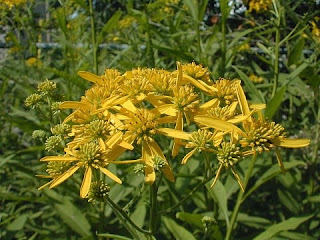Wingstem is Verbesina alternifolia flowering native for the landscape
Sometimes called Yellow Iron Weed, Wingstem is an American native perennial plant for butterflies and wildlife. They grow 5 feet tall with a central, winged stem. Crownbeard is another common name.
I'd show you a photo of ours but I just put two of them in the ground today and they aren't much to look at yet. They were purchased from MaryAnn King at Pine Ridge Gardens Nursery in Arkansas. According to one provider, Nodding Onion Gardens in Ohio, each plant will grow 6 to 8 feet tall in zones 5 through 9.
They want full sun to part shade so they were a perfect addition to the end of one of the perennial beds that needed a few more substantial plants in it.
Ill Wildflowers also says "The flowers are visited primarily by long-tongued bees, especially bumblebees. Some short-tongued bees, butterflies, and skippers also visit the flowers; the long tubes of the disk florets make the nectar inaccessible to many insects with shorter tongues, such as flies and wasps.
The caterpillars of the butterfly Chlosyne nycteis (Silvery Checkerspot) feed on the foliage, while the caterpillars of Basilodes pepita (Gold Moth) feed on the flowers and developing seeds The caterpillars of another moth, Cremastobombycia ignota, are leaf-miners.
Other insects that feed on Wingstem include the leaf beetle Brachypnoea clypealis, the aphids Uroleucon ambrosiae and Uroleucon rurale, Acrosternum hilaris (Green Stink Bug), and other polyphagous stink bugs.
Because of the bitterness of its leaves, Wingstem isn't consumed by deer, rabbits, and other herbivores to the same extent as many other plants. Animals may distribute the awned seeds to some extent."
Plants for Bees website says it is also called Golden Honey Plant. They also call it raucous.
"The species is a rather raucous perennial that grows to 9 ft.
One of its more obvious characteristics is that it has longitudinal (running up and down) thin projections (usually 4) issuing from the stem. Such projections are generally called wings, and hence the name wingstem.
The leaves get to be 10 inches in length. While they are usually alternately placed on the upper portions of the plant, the leaves can also be oppositely placed, especially on the lower portions, or the leaves may occur in groups of three.
The flower heads are 1-2 inches across and spread in all directions to form a kind of globular head."
Louis the Plant Geek makes Wingstem sound equally intriguing - " ... the flowers. They seem thrust skyward at such speed that the petals are aerodynamically cocked backward. And in the center, jumping out to greet the sky, the little florets. They seem either like a jaunty pincushion or a colony of Dr. Seussish micro-bobbles, dedicated to their discussions of the day."
Can't wait till ours take root and go for it!
 |
| Wingstem - Illinois Wildflowers page |
I'd show you a photo of ours but I just put two of them in the ground today and they aren't much to look at yet. They were purchased from MaryAnn King at Pine Ridge Gardens Nursery in Arkansas. According to one provider, Nodding Onion Gardens in Ohio, each plant will grow 6 to 8 feet tall in zones 5 through 9.
They want full sun to part shade so they were a perfect addition to the end of one of the perennial beds that needed a few more substantial plants in it.
Ill Wildflowers also says "The flowers are visited primarily by long-tongued bees, especially bumblebees. Some short-tongued bees, butterflies, and skippers also visit the flowers; the long tubes of the disk florets make the nectar inaccessible to many insects with shorter tongues, such as flies and wasps.
The caterpillars of the butterfly Chlosyne nycteis (Silvery Checkerspot) feed on the foliage, while the caterpillars of Basilodes pepita (Gold Moth) feed on the flowers and developing seeds The caterpillars of another moth, Cremastobombycia ignota, are leaf-miners.
 |
| Wingstem native range |
Other insects that feed on Wingstem include the leaf beetle Brachypnoea clypealis, the aphids Uroleucon ambrosiae and Uroleucon rurale, Acrosternum hilaris (Green Stink Bug), and other polyphagous stink bugs.
Because of the bitterness of its leaves, Wingstem isn't consumed by deer, rabbits, and other herbivores to the same extent as many other plants. Animals may distribute the awned seeds to some extent."
Plants for Bees website says it is also called Golden Honey Plant. They also call it raucous.
"The species is a rather raucous perennial that grows to 9 ft.
One of its more obvious characteristics is that it has longitudinal (running up and down) thin projections (usually 4) issuing from the stem. Such projections are generally called wings, and hence the name wingstem.
The leaves get to be 10 inches in length. While they are usually alternately placed on the upper portions of the plant, the leaves can also be oppositely placed, especially on the lower portions, or the leaves may occur in groups of three.
The flower heads are 1-2 inches across and spread in all directions to form a kind of globular head."
Louis the Plant Geek makes Wingstem sound equally intriguing - " ... the flowers. They seem thrust skyward at such speed that the petals are aerodynamically cocked backward. And in the center, jumping out to greet the sky, the little florets. They seem either like a jaunty pincushion or a colony of Dr. Seussish micro-bobbles, dedicated to their discussions of the day."
Can't wait till ours take root and go for it!



Comments
I wrote a story about native plants for the Oct, 2013, Oklahoma Gardening magazine and interviewed Mary Ann King who owns Pine Ridge Gardens. I bought those Wingstems from her.
She knows all there is to know about zone 7 natives!
If you want to peruse the catalog it is at http://www.pineridgegardens.com/